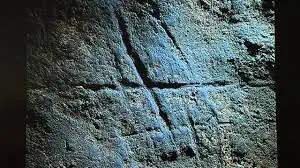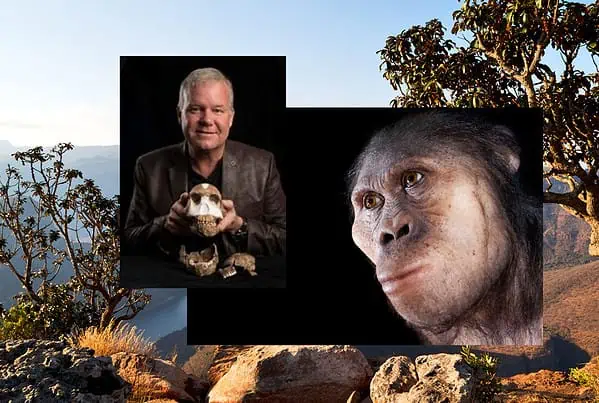Homo naledi paper by Lee Berger, John Hawks, Agustin Fuentes, Keneiloe Molopyane, and four other top paleo-anthropologists has just been released…
Berger’s team has concluded in their Homo naledi paper, released July 7,
241,000 to 335,000 Years Old Rock Engravings Made by Homo naledi in the Rising Star Cave system, South Africa (biorxiv.org)
 It is unlikely that any other hominin population made these engravings. No physical or cultural 195 evidence of any other hominin population occurs within this part of the cave system, and there is no evidence that recent humans or earlier hominins ever entered any adjacent area of the cave until surveys by human cave explorers during the last 40 years.
It is unlikely that any other hominin population made these engravings. No physical or cultural 195 evidence of any other hominin population occurs within this part of the cave system, and there is no evidence that recent humans or earlier hominins ever entered any adjacent area of the cave until surveys by human cave explorers during the last 40 years.
Berger’s big announcement came on June 5. It was made in Washington, DC. We reported here at Subspecieiest. on June 6:
Today Dr. Berger held a worldwide press conference at Stony Brook University in Long Island, New York. Stony Brook has a longstanding first rate human evolution department and has sponsored numerous human origins forums over the years.
Berger further stated on Australia Radio:
I announced in December, that we found fire. Within the next couple of months you are going to see extraordinary discoveries that we made. We’re on the verge of for the first time in human history being able to examine, a non-human species with culture.
CNN reported on the day of the announcement on the cross-hatch engravings,
Mysterious species buried their dead and carved symbols 100,000 years before humans
 During the work to identify the cave burials, the scientists also found a number of symbols engraved on the cave walls, which are estimated to be between 241,000 and 335,000 years old, but they want to continue their testing for more precise dating.
During the work to identify the cave burials, the scientists also found a number of symbols engraved on the cave walls, which are estimated to be between 241,000 and 335,000 years old, but they want to continue their testing for more precise dating.
The symbols include deeply carved hashtag-like cross-hatchings and other geometric shapes. Similar symbols found in other caves were carved by early Homo sapiens 80,000 years ago and Neanderthals 60,000 years ago and were thought to have been used as a way to record and share information.
Berger’s announcement received an enormous amount of publicity worldwide, from the NY Times, Washington Post, National Geographic, UK Daily Mail, The Guardian, Paris media, India Today, Jerusalem Post and countless other print and online media outlets.
“The problem is they are ahead of the science” — Michael Petraglia
Berger’s announcement was greeted with great applause and enthusiasm by longtime Homo naledi aficionados and Lee Berger fans. However, in the paleo-anthropology community it was more mixed. Some prominent paleo-anthropologists grumbled. Their attitude seemed to be along the lines of, let’s wait til the papers come out with hard data that can be analyzed. Others objected to Lee Berger’s showmanship and almost P.T. Barnum type personality. Two of the top critics included paleo-anthropologists often cited here at Subspecieist – Maria Martinon-Torres of Spain and Michael Petraglia of Australia.
From the NY Times:
 But a number of experts on ancient engravings and burials said that the evidence did not yet support these extraordinary conclusions about Homo naledi. The cave evidence found so far could have a range of other explanations, they said. The skeletons might have been merely left on the cave floor, for example. And the charcoal and engravings found in the cave might have been left by modern humans who entered long after Homo naledi became extinct.
But a number of experts on ancient engravings and burials said that the evidence did not yet support these extraordinary conclusions about Homo naledi. The cave evidence found so far could have a range of other explanations, they said. The skeletons might have been merely left on the cave floor, for example. And the charcoal and engravings found in the cave might have been left by modern humans who entered long after Homo naledi became extinct.
“It seems that the narrative is more important than the facts,” said Maxime Aubert, an archaeologist at Griffith University in Australia.
Continuing:
But María Martinón-Torres, the director of Spain’s National Research Center on Human Evolution, said that such speculations were premature based on the evidence presented so far. “Hypotheses need to be built on what we have, not what we guess,” she said.
Dr. Martinón-Torres considered funerary caching more likely than burials, pointing out that the oval depressions did not contain full skeletons in complete alignment. If Homo naledi brought the bodies into the cave and left them on the cave floor, the bones could have become separated as the bodies decomposed. “Still, I think the possibility of having funerary caching with this antiquity is already stunning,” she said.
Petraglia is quoted:
“I’m highly optimistic that they have burials, but the jury is still out,” said Michael Petraglia, the director of the Australian Research Center for Human Evolution… “The problem is that they’re ahead of the science,” he said.
At the very heart of Berger’s announcements, was his description of hashtag like markings near the entrance of one of the chambers where burials of Homo naledi children were found.
Rick Potts of the Smithsonian is quoted at the NY Times:
 “Scientists haven’t yet been able to identify how old the engravings are. So Potts said the current evidence can’t say for sure whether H. naledi was truly the one to create the symbols, or if some other creature — maybe even H. sapiens — made its way down there at some point.”
“Scientists haven’t yet been able to identify how old the engravings are. So Potts said the current evidence can’t say for sure whether H. naledi was truly the one to create the symbols, or if some other creature — maybe even H. sapiens — made its way down there at some point.”
Berger et.al. emphatically respond in the paper, that the available evidence is “most compatible,” with Homo naledi having made the markings. Though the team does concede it is possible that the markings were made by early Homo sapiens, or even modern Cavers.
There is no evidence of modern cavers altering cave walls in such a manner in the Dinaledi 200 subsystem, or elsewhere in Rising Star system. The evidence that these engravings were created in multiple events over time further makes it unlikely that historic humans were involved in their creation. The available evidence is most compatible with the extinct species Homo naledi as the creator of these markings.
The evidence of burials and associated mortuary practices by H. naledi near the engravings 205 reinforces that assertion this species carried out repeated complex patterns of behaviour in this deep cave setting.
A key point made in the new paper, by Berger and Agustin Fuentes of Princeton University, is that the engravings greatly resemble markings etched on cave walls at Gibraltar by Neanderthals ~60,000 years ago, and tiny hatched markings made on a single mussel shell by Homo erectus at Java, Indonesia.
The team conclude:
With the engravings reported here we add to this growing dataset by providing 245 additional evidence of later Pleistocene engravings associated with a non-Homo sapiens hominin. We also add to the complexity involved in examining and understanding the implications of such engravings by reporting that the most likely creator of these engravings wasthe small-brained Homo naledi. This has implications for the evolution of biological intelligence among hominins and the association with encephalization with cognitive complexity


There are two contemporaneous species of Homo — pre-modern sapiens and heidelbergensis/rhodesiensis — living in Africa, abundantly shown to be more advanced and capable than the entirely-speculative Homo naledi. Both used fire.
So the scribed “naledi” hashtag resembles some Neanderthal markings in Europe. Consistent with Berger’s standards this is evidence they all subscribed to Twitter and played tic-tac-toe.
“Hypotheses need to be built on what we have, not what we guess,” says a Berger critic.
No, not at all. An hypothesis is a guess, and nobody has the right to shut down guessing by others. In fact, the process of science requires guessing and the unconditional freedom to guess. Berger’s guesses are his to make.
“The problem is that they’re ahead of the science,” is another criticism.
Exactly. His guesses have not yet been scrutinized by the rigors, disciplines and structures of scientific inquiry and he knows it.
Berger may feel justified in misrepresenting tenuous and ambiguous evidence as highly-probable “fact.”
Doing that could be an act of faith, intuition, ideology or ego. But it isn’t science.
I’ve previously noted the Berger team’s omission of at least publicly releasing the radiocarbon dating of discovered charcoal. The only thing I could find was their sniff that, well, that wouldn’t hold much value since naledi was far older than the effective range of that method.
But whether positive or negative the results at least could find whether the burning took place within the past 60,000 years, right? Wouldn’t you want to nail that down rather than guessing naledi’s vintage?
Oh wait, but there’s this: https://johnhawks.net/weblog/ancient-fire-use-rising-star/
” . . . finding a few recent dates doesn’t make things easy at all. Two naledi bones yielded radiocarbon dates between 36,000 and 33,000 BP. We very much considered whether these naledi bones may actually be this young, and today I still would not categorically rule this out. . . . To explain the inconsistency, the team hypothesized that the radiocarbon results reflect contamination by carbon from outside the bones.”
Say what?
Unless they’re thinking one of their people hinked things by lighting up a Lucky Strike, either of the two alternatives throws a hand grenade in their reasoning:
If the 35,000 yr radiocarbon results are from naledi bones, what does that say about their narrative that what we have is an ancient mausoleum? Used over 300,000 years — 15,000 generations — by a single species of small-brained hominin. Really??
But if the recent dates didn’t come from the bones, that ancient carbon they measured had to get in the cave some how some way. And Berger steadfastly claims that there have been no intrusions into the cave system by anyone or anything other than naledi.
It pains me to say it, but it looks like Berger is cherry-picking data in support of extreme favorite pet narratives. How can you not take it that way ?
It appears that the Berger team is headed toward the conclusion that naledi is essentially a late-era australopithecine, separate from those that diverged to Homo erectus and toward the sapiens line. Naledi is seen to have developed some features once thought to be exclusively human, but
“Dinaledi dental and skeletal material is morphologically quite distinct from contemporaneous Eurasian and other African Middle Pleistocene Homo samples. The short stature, small body mass, and absolute and relative encephalization of H. naledi are on par with Australopithecus and Paranthropus; additionally, its curved manual phalanges and an Australopithecus-like hip are out of step with fossils attributed to H. sapiens and Homo neanderthalensis.”
https://www.sciencedirect.com/science/article/abs/pii/S0047248423000519
Existing in Africa at the same time as advanced Homo, one has to wonder about the nature of the fate leading to their extinction. . . .
Some peer review critique of the three Berger Bunch papers (and his retorts to them) can be had here:
https://elifesciences.org/reviewed-preprints/89106/reviews
The Berger saga on Netflix is as bad as some dreaded. I think a separate article post about that would be warranted, there’s a lot of detritus to wade through in more ways than one.
Well here we are a couple of months later and Lee Berger has done it again: He’s sent Homo naledi and Australopithecus sediba remains into outer space for no scientific purpose at all.
https://www.space.com/archaeologists-fuming-over-ancient-human-relative-remains-sent-to-space
This is now officially a carnie act, Berger has become the Zahi Hawass of paleoanthropology. That’s not good for him or the science.
Interestingly, it’s been announced that wooden artifacts such as sticks, wedges and chopped interlocking logs have been discovered in Zambia, some 600 miles north of the Dinaledi caves.
Luminescence dating is ranging 476kya to 324kya.
https://www.sciencenews.org/article/logs-evidence-oldest-wood-structure
https://www.nature.com/articles/s41586-023-06557-9